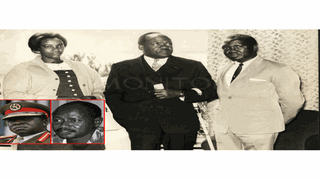
Former DP presidents Benedicto Kiwanuka (C) and Paul Ssemogerere (R) also worked with past governments. Inset is former Ugandan President Idi Amin Dada and incumbent President Museveni. PHOTOS/ FILE
|People & Power
Prime
When DP presidents worked with regimes in power
What you need to know:
- Although DP is Uganda’s oldest existing political party established in 1954, it was in power only briefly before Uganda attained independence in 1962.
On July 20, President Museveni fished deep in the Opposition waters. The catch was Democratic Party (DP) president general Norbert Mao.
On that Wednesday at State House, ruling National Resistance Movement (NRM) chairman Museveni and Mr Mao signed a two-party cooperation agreement.
A day after signing of the agreement, in a mini Cabinet reshuffle was announced in which President Museveni appointed Mr Mao the minister of Justice and Constitutional Affairs.
Mr Mao has since been approved by Parliament, although he insists he is still the DP president and has not joined the NRM government.
Background
Although he had to deal with a barrage of insults from his critics who accuse him of cosying up to the NRM regime, Mr Mao is not the first DP president to work with a ruling government.
Former party presidents Benedicto Kiwanuka and Paul Ssemogerere also worked with past governments, amid criticism.
Although DP is Uganda’s oldest existing political party established in 1954, it was in power only briefly before Uganda attained independence in 1962.
Amin appoints Ben Kiwanuka Chief Justice
In February 1971, former DP president general Benedicto Kiwanuka was among the many political prisoners then president Idi Amin set free from Luzira prison. Some of the released prisoners had been in jail since the 1966 Buganda Crisis.
ALSO READ: Why Mao jumped on the yellow bus
In June 1971, Amin appointed Kiwanuka acting Chief Justice, making him the first Ugandan to occupy the office. He was 49 years old. In February 1972, Amin approved Kiwanuka as the Chief Justice.
In September 1972, however, Kiwanuka was picked up from his chambers at the High Court in Kampala and taken by the Uganda Army operatives. He has never been seen again to this day.
In April 1979, Amin was toppled by a combination of the Tanzanian army and Uganda rebel forces. Between April 1979 and December 1980, Uganda was led by several governments.
On December 10, 1980, Uganda Peoples Congress (UPC), led by its then president Milton Obote, won the contested general election and formed a government.
DP president general at the time Paul Kawanga Ssemogerere became Leader of Opposition until July 1986, when the army once again ousted president Obote, and again the army commander, Gen Tito Okello Lutwa, became president. He also banned political parties and their activities.
Ssemogerere joined Lutwa’s junta/coalition government with several DP members. On January 26, 1986, National Resistance Army (NRA) rebels led by Yoweri Museveni ousted the Lutwa military government.
Museveni appoints Ssemogerere minister
On January 24, 1986, just hours before the NRA rebels led by Museveni captured Kampala, the rebel leaders sent for Ssemogerere and they held a meeting at Trinity College, Nabbingo. Ssemogerere was not accompanied by anyone.
During the meeting, Museveni and Ssemogerere reached a “gentleman’s agreement” to work together.
And so on January 29, 1986, Museveni was sworn in as President. During the occasion held at the steps of Parliament, President Museveni also abolished political parties and their activities.
On February 1, 1986, President Museveni named his first Cabinet and Ssemogerere was appointed minister of Internal Affairs. Ssemogerere went to work with Mr Museveni’s government with some of DP’s top brains.
They included Evaristo Nyanzi, the minister of Commerce; John Ssebaana Kizito, the minister of Regional Cooperation; Prof Yoweri Kyesimira, the minister for Planning and Economic Development; and Joseph Mulenga, minister of Justice and Attorney General.
Other DP members were appointed to several government institutions.
In 1988, President Museveni made a Cabinet reshuffle and Ssemogerere was appointed minister for Foreign and Regional Affairs, a portfolio he held until 1995 when he jumped ship.
The following year, Ssemogerere contested in the April 1996 presidential elections and lost to incumbent Museveni.
Banning parties
On December 21, 1969, the Uganda People Congress (UPC) government led by president Milton Obote banned all political parties and their activities in Uganda.
In January 1971, the Uganda Army toppled Obote elevated former army commander, Maj Gen Idi Amin to a four-star General and made him President. In February 1971, abolished Parliament and political parties and ruled by decree.




